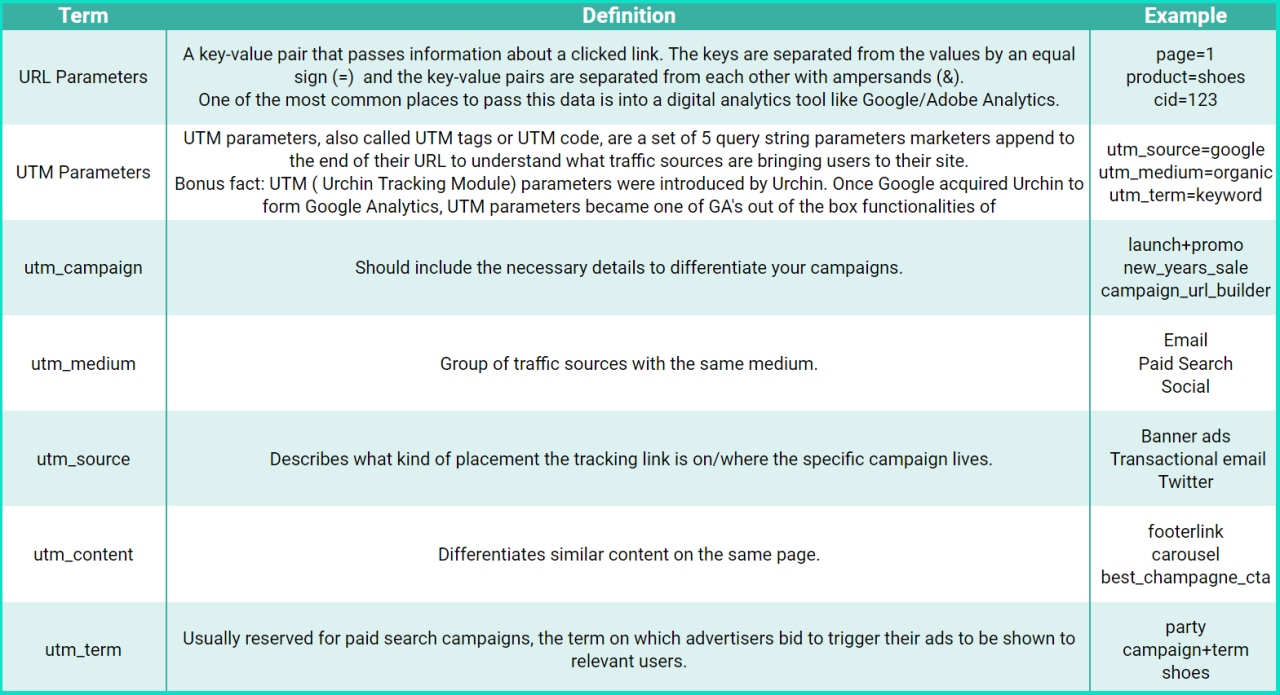
Use UTM Tracking for WordPress Success
Use UTM tracking to supercharge your WordPress website’s performance! This comprehensive guide dives deep into understanding, implementing, and analyzing UTM parameters to get the most out of your marketing efforts. We’ll cover everything from setting up basic tracking to advanced techniques for retargeting and personalized customer journeys.
Imagine having precise data on how different marketing channels are driving traffic to your WordPress site. UTM tracking makes this possible. We’ll explore the various types of UTM parameters, their purpose, and how they contribute to a better understanding of your audience and campaigns.
Understanding UTM Tracking
UTM tracking is a powerful tool for marketers to understand the effectiveness of their online campaigns. It allows you to precisely monitor how different marketing channels are driving traffic to your website and ultimately, converting leads into customers. By meticulously tracking the source and medium of each visit, you gain invaluable insights into which campaigns are performing best and where you can optimize your efforts for maximum impact.This in-depth exploration of UTM tracking will clarify its fundamental principles, highlighting the different parameter types, and demonstrating how this technology enhances marketing campaign performance.
We will also provide a practical example of a basic UTM tracking structure.
Definition of UTM Parameters
UTM parameters are snippets of code appended to URLs. These codes act as identifiers, providing insights into the origin and nature of traffic. They essentially tag website traffic with details about the source and medium of the visit, making it possible to attribute conversions and track the performance of various marketing efforts.
Purpose and Benefits of UTM Tracking
The primary purpose of UTM tracking is to measure the effectiveness of your marketing campaigns. By tracking the source, medium, and campaign of each visit, you gain a granular view of which channels are driving the most valuable traffic and conversions. This data is crucial for optimizing marketing budgets, improving campaign performance, and demonstrating the return on investment (ROI) of various marketing strategies.
Benefits include accurate attribution, enhanced campaign management, and data-driven decision-making.
Using UTM tracking is crucial for understanding where your website traffic is coming from, and it’s a fundamental part of any successful marketing strategy. Recently, I was particularly impressed by the Ignite Visibility team, who were awarded the “Best B2B Search Marketing Initiative” ignite visibility awarded best b2b search marketing initiative. Their dedication to maximizing search engine visibility is a testament to the power of well-executed campaigns, which heavily rely on data from effective UTM tracking.
Types of UTM Parameters
Understanding the different types of UTM parameters is vital for effectively interpreting your data. These parameters provide a detailed breakdown of the traffic source, the marketing channel used, and the specific campaign that generated the visit.
- Source: This parameter identifies the website or platform that referred users to your website. Examples include social media platforms (e.g., Facebook, Twitter), search engines (e.g., Google, Bing), or other websites (e.g., partner sites). Identifying the source helps you assess the effectiveness of different referral channels.
- Medium: This parameter specifies the channel used to drive traffic, such as social media (e.g., social), email (e.g., email), or paid search (e.g., cpc). It helps categorize and analyze the performance of various marketing channels, enabling targeted improvements.
- Campaign: This parameter represents a specific marketing initiative, such as a new product launch, a promotional campaign, or a seasonal event. The campaign parameter provides a way to track the performance of different marketing campaigns and measure their effectiveness.
- Term: This parameter is often used with search engine marketing. It defines the specific used to drive traffic to your site. It helps to identify which s are most effective in generating leads.
- Content: This parameter describes the specific piece of content that was used to drive traffic, such as a particular blog post or social media post. Identifying the content helps to understand which specific content pieces resonate best with your audience.
How UTM Tracking Improves Marketing Campaign Effectiveness
UTM tracking provides valuable insights into the performance of your marketing campaigns, allowing for informed decisions and adjustments. It facilitates precise attribution, enabling you to pinpoint the channels and campaigns generating the most significant results. This, in turn, allows you to allocate resources more effectively and optimize your marketing spend. It allows you to understand which channels and campaigns are driving the most valuable traffic and conversions, leading to more efficient marketing strategies.
Basic UTM Tracking Structure
A basic UTM tracking structure comprises a URL with appended UTM parameters. The format follows a consistent structure. For example:
| Parameter | Example Value |
|---|---|
| Source | |
| Medium | cpc |
| Campaign | new-product-launch |
| Term | best-running-shoes |
A complete example would be:https://www.example.com/?utm_source=google&utm_medium=cpc&utm_campaign=new-product-launch&utm_term=best-running-shoes
Implementing UTM Tracking
Understanding UTM parameters is crucial for measuring the effectiveness of your marketing campaigns. Implementing UTM tracking correctly allows you to attribute website traffic to specific sources, campaigns, and channels, providing valuable insights into what’s working and what needs improvement. This detailed guide walks you through the steps involved in setting up UTM tracking across various platforms and channels.Setting up UTM tracking is a straightforward process that unlocks valuable insights into your marketing performance.
By correctly implementing UTM parameters, you gain a deeper understanding of how different marketing efforts contribute to website traffic and conversions. This process involves integrating UTM tracking into your website analytics platform and various marketing channels, ensuring that every click can be traced back to its origin.
Setting up UTM Tracking in Google Analytics
To start tracking UTM parameters in Google Analytics, you’ll need to configure your website to send data to the platform. This usually involves adding a tracking code snippet to your website’s HTML. The specific steps depend on your website platform (e.g., WordPress, custom-built), but generally involve:
- Finding the Google Analytics tracking ID for your website.
- Integrating the tracking code into your website’s header or footer.
- Verifying the implementation by checking for the tracking code presence in your website’s source code.
Formatting UTM Parameters
Correctly formatting UTM parameters is essential for accurate tracking. The standardized format allows for easy interpretation and analysis of campaign data. The following table Artikels the key UTM parameters and their use:
| Parameter | Description | Example Value |
|---|---|---|
| utm_source | The source of the traffic (e.g., Google, social media). | |
| utm_medium | The medium used to drive traffic (e.g., cpc, email). | cpc |
| utm_campaign | The name of the marketing campaign. | summer_sale |
| utm_term | used in search engine campaigns. | best_shoes |
| utm_content | Specific content within a campaign (e.g., ad variations). | banner_1 |
Proper UTM parameter formatting ensures accurate attribution and analysis.
Integrating UTM Tracking into Marketing Channels
Integrating UTM tracking into your marketing channels is a crucial step in gathering comprehensive data. This includes social media, paid ads, and email campaigns. Each platform has its own method for adding UTM parameters.
- Social Media: Adding UTM parameters to social media links involves constructing the link with the required parameters, usually in the format `yourwebsite.com?utm_source=facebook&utm_medium=social&utm_campaign=new_products`. Tools on social media platforms may allow you to directly add parameters when sharing links.
- Paid Ads: Platforms like Google Ads and social media ad platforms provide options to incorporate UTM parameters in ad campaigns. This is often done via the platform’s ad creation interfaces. Correctly adding parameters to ad campaigns is essential for effective campaign tracking and analysis.
- Email Marketing: UTM parameters can be added to email links to track clicks from email campaigns. Tools such as Mailchimp and Constant Contact offer options for adding UTM parameters to your email campaigns. This feature helps track the effectiveness of email marketing efforts and identify which campaigns generate the most engagement.
Flowchart for Implementing UTM Tracking
[A flowchart illustrating the process of implementing UTM tracking would be visually represented here. It would begin with defining the marketing campaign and proceed through steps of setting up Google Analytics, formatting UTM parameters, and integrating them into various marketing channels. The flowchart would conclude with monitoring and analyzing the data.]
Examples of UTM Tracking Implementations
Several examples of different UTM tracking implementations are detailed below.
- Example 1: A Facebook ad campaign promoting a new product. The UTM parameters would be added to the link for the landing page, allowing tracking of traffic from that specific campaign. The link could look like `yourwebsite.com/newproduct?utm_source=facebook&utm_medium=cpc&utm_campaign=new_product_launch&utm_content=banner_ad`.
- Example 2: A blog post shared on Twitter. A UTM parameter-containing link for the post would be used to track the traffic from the social media platform. The link could look like `yourwebsite.com/blogpost?utm_source=twitter&utm_medium=social&utm_campaign=blog_promotion&utm_content=tweet`. This example demonstrates the use of UTM parameters in tracking referral traffic from different sources.
Analyzing UTM Tracking Data
Now that you’ve implemented UTM tracking, it’s time to delve into the treasure trove of data it provides. Analyzing this data is crucial for understanding the effectiveness of your marketing campaigns and making informed decisions for future optimization. This section will explore various metrics, key performance indicators (KPIs), and practical examples of how to interpret your UTM data.
Metrics to Track with UTM Parameters
A comprehensive UTM analysis involves tracking several key metrics. These metrics, when combined, paint a clear picture of how different marketing channels perform and which channels resonate most with your target audience.
- Website traffic sources: Understanding which channels (e.g., social media, paid search, email) are driving the most traffic to your website is paramount. UTM parameters allow you to pinpoint the origin of this traffic.
- Conversion rates: Monitor the percentage of visitors who complete a desired action (e.g., making a purchase, signing up for a newsletter). This crucial metric directly reflects the effectiveness of your campaigns.
- Click-through rates (CTR): This metric measures the percentage of users who click on your ad or link from a specific channel. A higher CTR signifies that your ad copy and targeting strategies are resonating with your audience.
- Average session duration: Track the average time users spend on your website after clicking on a UTM-tagged link. This metric reveals engagement levels and how compelling your content is.
- Bounce rate: The bounce rate represents the percentage of users who leave your website after viewing only one page. A high bounce rate might suggest that your landing pages are not relevant or engaging to the users arriving from a specific channel.
Key Performance Indicators (KPIs) Derived from UTM Data
Identifying and focusing on specific KPIs derived from your UTM data allows you to measure the success of your marketing efforts. These KPIs can be tailored to your specific business objectives.
- Return on Investment (ROI): Calculate the return on your marketing spend by tracking the revenue generated from each channel. This metric helps you identify which campaigns are yielding the best results.
- Cost per Acquisition (CPA): Calculate the cost incurred to acquire a new customer through a specific marketing channel. A lower CPA signifies more efficient campaign management.
- Customer Lifetime Value (CLTV): Estimate the total revenue a customer is expected to generate throughout their relationship with your business. Understanding CLTV allows you to prioritize channels that attract high-value customers.
Interpreting UTM Data for Campaign Optimization
Analyzing UTM data enables you to identify areas for improvement and fine-tune your campaigns. This iterative process allows for continuous optimization and enhanced results.
For example, if a specific social media campaign is driving high traffic but low conversion rates, you can investigate the landing page’s relevance and adjust it to better meet the needs of the visitors coming from that source. A/B testing landing pages can provide valuable insights.
Examples of Analyzing UTM Data to Understand Customer Behavior
UTM data provides insights into customer behavior, helping you tailor your marketing strategy. For instance, if you observe that users from a particular paid search campaign are spending significantly more time on a specific product page, it indicates that the campaign’s targeting is effective for this product category.
Sample Data Table
| Campaign Source | Medium | Campaign Name | Visits | Conversions | Conversion Rate |
|---|---|---|---|---|---|
| Google Ads | cpc | Winter Sale | 500 | 100 | 20% |
| Social Media | social | Holiday Promotion | 300 | 50 | 16.7% |
| Email Marketing | Newsletter Campaign | 200 | 30 | 15% |
Best Practices and Considerations
UTM tracking, while powerful, requires careful implementation and maintenance. Ignoring best practices can lead to inaccurate data, hindering your ability to understand campaign performance and optimize future efforts. This section details common pitfalls, strategies for improvement, and essential upkeep procedures.Effective UTM tracking isn’t a one-time setup; it demands ongoing attention and adaptation to maintain its accuracy and value. By understanding common mistakes, employing robust strategies, and adhering to consistent practices, you can maximize the utility of your UTM parameters and unlock actionable insights from your data.
Common Mistakes in UTM Tracking
Incorrectly formatted UTM parameters are a frequent source of errors. Misspellings, missing components, or incorrect character encoding can invalidate the tracking data, rendering it useless for analysis. Other common mistakes include inconsistent naming conventions across campaigns, which make data comparisons difficult, and neglecting to track all relevant channels or campaigns, creating gaps in your data picture.
Strategies for Improving UTM Tracking Accuracy
Regularly validating UTM parameters against the official Google Analytics documentation ensures adherence to the correct syntax and avoids common errors. Implementing robust data validation checks can catch typos and ensure that parameters are properly formatted. Employing automated tools for generating UTM parameters can reduce manual errors and maintain consistency across campaigns.
Maintaining and Updating UTM Tracking Setup
Keeping UTM tracking up-to-date involves reviewing and adjusting parameters periodically. New channels, campaigns, and landing pages require corresponding UTM modifications. Regularly review the list of tracked campaigns and landing pages, ensuring that parameters are still relevant and accurate.
Importance of Consistent Naming Conventions
Consistent naming conventions for UTM parameters streamline data analysis. A standardized approach allows for easy comparisons between campaigns and channels, facilitating more effective campaign optimization. Using a naming convention that clearly distinguishes campaign types (e.g., “social_media_campaign,” “paid_search_campaign”) will help in differentiating them in reports. For example, use a structured format like “campaign_name-source-medium-term”.
Advanced UTM Tracking Techniques
Using UTM parameters for A/B testing allows for the tracking of variations in landing pages, ad copy, or other elements of a campaign. This enables direct comparison of performance metrics between different variations and provides data-driven decisions on which elements perform best. This is particularly valuable in optimizing conversion rates. For example, if you are testing two versions of a landing page, you can assign different UTM parameters to each variation to accurately track their performance.
Another advanced technique is using UTM parameters for specific user segments. For example, if you want to track the performance of a campaign targeted at users who have previously visited your site, you can add a UTM parameter to identify these users. This helps isolate the effect of retargeting campaigns on conversions, or even monitor the impact of different marketing channels on different user segments.
| Technique | Description |
|---|---|
| A/B Testing | Tracking variations in landing pages, ad copy, etc. for optimized performance. |
| User Segmentation | Identifying specific user segments to isolate the effect of marketing campaigns on particular user groups. |
Tools and Resources: Use Utm Tracking

Armed with a solid understanding of UTM parameters, you’re ready to integrate them into your marketing strategy. But the work doesn’t end there. Effective UTM tracking requires the right tools and resources to implement, manage, and analyze the data. This section dives into the available resources for learning and implementing UTM tracking, offering practical examples and comparisons to help you choose the best tools for your needs.The abundance of online tools and resources can be overwhelming.
Using UTM tracking is crucial for understanding which channels are driving the most valuable leads. For example, if you’re running Facebook lead form ads that convert (check out this awesome resource: facebook lead form ads that convert ), you’ll want to be able to precisely measure the effectiveness of those ads. Knowing which UTM parameters are associated with those conversions allows you to optimize your overall marketing strategy.
However, with a structured approach, selecting the optimal tools for your specific requirements becomes significantly easier. By exploring the various options and comparing their functionalities, you can identify the tools that best align with your team’s workflow and analytical capabilities.
Learning Resources
Various resources provide in-depth information on UTM tracking. These resources range from comprehensive guides to practical tutorials, equipping you with the knowledge to master UTM tracking. Online tutorials, blog posts, and documentation from marketing platforms are valuable sources for gaining a deeper understanding.
- Search Engine Optimization () resources like Moz, Search Engine Journal, and SEMrush offer articles and tutorials dedicated to UTM tracking and its best practices.
- Marketing blogs and forums provide valuable insights from practitioners and experts in the field, sharing practical experiences and real-world examples.
- Many marketing platforms, such as Google Analytics, offer detailed documentation and support resources that explain UTM tracking implementation and best practices within their platform.
UTM Tracking Tools
Several tools support UTM tracking implementation. Choosing the right tool depends on your specific needs and existing workflow.
- Google Analytics is a widely used platform for UTM tracking. Its robust features allow for detailed data analysis and reporting.
- Marketing automation platforms like HubSpot, Marketo, and Pardot offer built-in UTM tracking capabilities, often integrated with other marketing tools for a streamlined workflow.
- Dedicated UTM parameter generators simplify the creation and management of UTM tags, freeing up time for other tasks. These tools often offer customizable options for tailoring the tracking parameters to specific needs.
Comparing UTM Tracking Tools, Use utm tracking
The following table provides a comparative overview of different UTM tracking tools, highlighting their key features and capabilities.
| Tool | Key Features | Pros | Cons |
|---|---|---|---|
| Google Analytics | Comprehensive analytics, robust reporting, integration with other Google services | Free, powerful analysis, extensive documentation | Requires a Google account, may need additional setup for complex tracking |
| HubSpot | Integrated with other HubSpot marketing tools, CRM functionality | Streamlined workflow, centralized data management | May require a paid subscription for advanced features |
| UTM Parameter Generators (e.g., UTM.io) | Easy parameter creation, customizable options, often mobile-friendly | Quick and easy implementation, user-friendly interfaces | Limited analytical capabilities, might not be ideal for extensive tracking |
Managing UTM Parameters
Effectively managing UTM parameters across various platforms is crucial for accurate tracking. Different platforms offer diverse methods for implementing and managing UTM tags.
- Many marketing platforms provide tools and interfaces specifically designed for creating and managing UTM parameters. These interfaces typically allow for easy input and customization of parameters.
- Spreadsheet applications like Google Sheets or Microsoft Excel can be used for organizing and tracking UTM parameters for different campaigns and channels. This method is suitable for smaller-scale implementations or those without dedicated marketing software.
- Consider using dedicated UTM parameter generators. These tools are specifically designed for creating and managing UTM tags. They simplify the process and ensure accuracy by providing a streamlined interface.
Troubleshooting UTM Tracking Issues
Troubleshooting UTM tracking problems is essential to ensure accurate data collection and analysis.
Using UTM tracking is crucial for understanding where your website traffic is coming from, and that includes Bing search results. To optimize your Bing SEO strategy, it’s important to know which keywords and campaigns are driving the most valuable clicks. This detailed information helps you refine your approach and ultimately boost your website’s visibility on Bing, allowing you to utilize your UTM tracking to its fullest potential.
Bing SEO is a key component in maximizing your online presence, making sure you’re getting the most out of your UTM data.
- Double-check the accuracy of the UTM parameters entered in the URL. Typos or incorrect syntax can significantly affect data accuracy.
- Verify the integration of the tracking code with the target platform. Ensure that the code is properly implemented and activated.
- Monitor the data collected in the chosen platform. Identify any discrepancies or anomalies that may indicate issues with the tracking setup.
Case Studies and Examples
UTM tracking, when implemented effectively, can provide invaluable insights into marketing campaign performance. This allows for informed decisions about budget allocation, channel optimization, and overall marketing strategy. By understanding which campaigns drive the most valuable conversions, businesses can refine their approach and maximize return on investment. This section will detail successful implementations, explore various campaign types, and illustrate how UTM data can improve marketing ROI across different industries.
A Successful UTM Tracking Implementation
A hypothetical online retailer, “TrendyThreads,” implemented UTM parameters across all digital marketing channels. They tracked website traffic from various sources, including social media ads, email campaigns, and search engine results pages (SERPs). This comprehensive tracking allowed them to identify which channels generated the most qualified leads and sales. For example, they discovered that targeted Facebook ads resulted in a higher conversion rate compared to organic social media posts.
This insight allowed TrendyThreads to reallocate a portion of their marketing budget towards more effective channels.
Examples of Tracked Campaigns
- Email Campaigns: UTM parameters were added to email links, enabling TrendyThreads to track open rates, click-through rates (CTRs), and conversions directly attributable to specific email campaigns. This allowed them to segment their audience effectively and personalize email content for better engagement.
- Social Media Ads: UTM parameters were used in social media ad links. TrendyThreads could then measure the traffic generated from different social media platforms, such as Instagram and Facebook, and understand which ad creatives and targeting strategies yielded the best results. For instance, they discovered that ads featuring user-generated content performed significantly better than those with professionally produced images.
- Search Engine Marketing (SEM): UTM parameters were incorporated into paid search ads. This enabled TrendyThreads to evaluate the effectiveness of different s and ad copy variations. They found that incorporating specific product names in their ad copy resulted in a higher click-through rate.
Campaign Performance Report
UTM tracking data provides a detailed picture of campaign performance.
The following table illustrates a sample campaign performance report for TrendyThreads’ social media advertising campaign:
| Source | Campaign | Visits | Conversions | Conversion Rate |
|---|---|---|---|---|
| Facebook Ads | Autumn Fashion | 1500 | 300 | 20% |
| Instagram Ads | Autumn Fashion | 1200 | 250 | 21% |
| Organic Social Media | Autumn Fashion | 800 | 100 | 12.5% |
Improved Marketing ROI
The data from UTM tracking allowed TrendyThreads to refine their marketing strategies and optimize their budget allocation. By focusing on high-performing channels like Facebook ads, they significantly improved their marketing ROI. The increased conversion rates and higher volume of sales directly resulted from a deeper understanding of customer behavior and a more effective targeting strategy.
Different Industries’ Usage
- E-commerce: E-commerce businesses leverage UTM tracking to analyze traffic sources, measure the effectiveness of various marketing channels, and optimize their online advertising strategies. This helps them understand which channels are most effective for driving sales and conversions.
- Software as a Service (SaaS): SaaS companies use UTM parameters to track the effectiveness of their lead generation campaigns, identify the channels that generate the highest quality leads, and measure the ROI of their marketing initiatives. This allows them to focus their efforts on strategies that yield the best results.
- Real Estate: Real estate agents utilize UTM tracking to understand which marketing channels are most effective for attracting potential buyers and sellers. This allows them to refine their lead generation strategies and maximize their sales potential.
Advanced UTM Tracking
UTM tracking, while fundamental for basic campaign analysis, truly shines when leveraged for more sophisticated marketing strategies. This advanced application goes beyond simply measuring traffic sources and delves into retargeting, personalized experiences, and integrations with other tools to unlock deeper insights and more effective campaigns. This section will explore the nuances of advanced UTM tracking, demonstrating its potential to optimize performance and drive better ROI.Understanding the intricate connections between your marketing efforts and customer actions is crucial for effective campaign management.
UTM parameters, when strategically implemented, provide a powerful lens into this relationship, allowing for the tracking of nuanced user interactions.
Retargeting Campaigns with UTM Parameters
Retargeting campaigns leverage user data to re-engage potential customers who have previously interacted with your website. UTM parameters are essential for identifying these users and creating targeted ads. By tagging each ad with specific UTM parameters, you can accurately track the effectiveness of retargeting efforts, differentiating between different ad campaigns and audience segments. This detailed tracking allows for a better understanding of which ads are most successful in re-engaging past visitors and converting them into customers.
Personalized Customer Journeys with UTM Tracking
UTM parameters allow for the creation of highly personalized customer journeys. By capturing detailed information about how users interact with your website through different channels, you can tailor subsequent interactions to their specific interests and needs. This personalized approach can significantly improve conversion rates by providing a more relevant and engaging experience. For example, a user who viewed a product page for a specific item can be retargeted with ads showcasing similar items, fostering a more relevant customer journey.
Integrating UTM Tracking with Marketing Automation Tools
Modern marketing relies heavily on automation tools. UTM parameters seamlessly integrate with these tools, enabling more comprehensive tracking and analysis. By linking UTM tags to marketing automation platforms, you can automatically segment users based on their interaction with specific marketing campaigns. This integration allows for more targeted email campaigns, personalized content recommendations, and enhanced lead nurturing. For instance, users who downloaded a whitepaper through a specific UTM-tagged link can be automatically added to a nurturing sequence for follow-up communications.
Creating Custom UTM Parameters for Specific Needs
While standard UTM parameters cater to general needs, you may require more granular tracking. Custom UTM parameters allow for the tailoring of tracking to specific campaign elements or business objectives. This is crucial for deep dives into specific campaign elements or unique marketing efforts. Imagine tracking a particular offer on a specific product. You could add custom parameters to accurately identify which specific campaign or offer led to a conversion.
Measuring Content Marketing Asset Impact with UTM Tracking
UTM tracking allows for the meticulous measurement of the impact of specific content marketing assets, such as blog posts, ebooks, or infographics. By associating unique UTM parameters with each piece of content, you can precisely determine how many visitors engage with it, which leads to conversions, and how it influences other marketing channels. This detailed analysis provides valuable insights into the effectiveness of your content marketing strategy, enabling you to optimize future content creation for improved performance.
Conclusive Thoughts
In conclusion, implementing UTM tracking is essential for optimizing your WordPress website’s marketing campaigns. By meticulously tracking your data, you’ll gain valuable insights into user behavior, campaign performance, and return on investment. Understanding these metrics empowers you to make informed decisions, refine your strategies, and ultimately achieve greater success.





